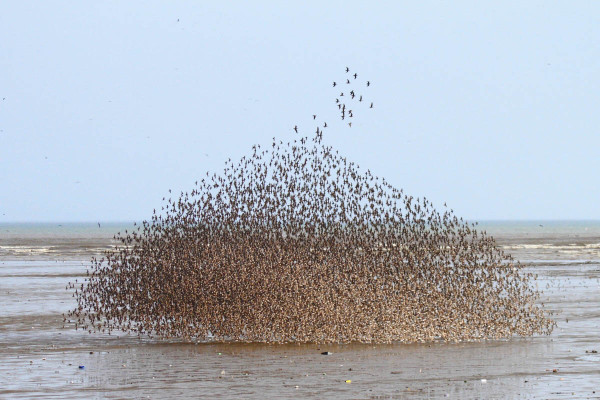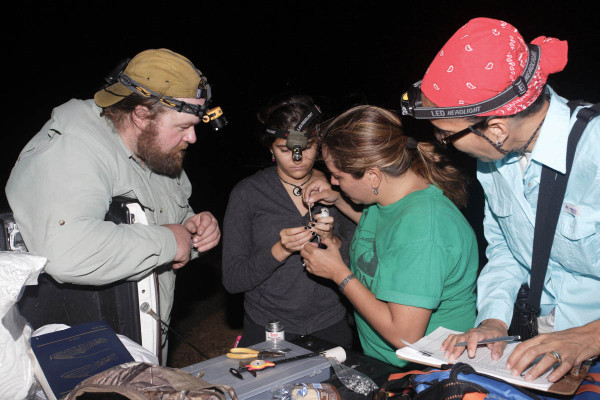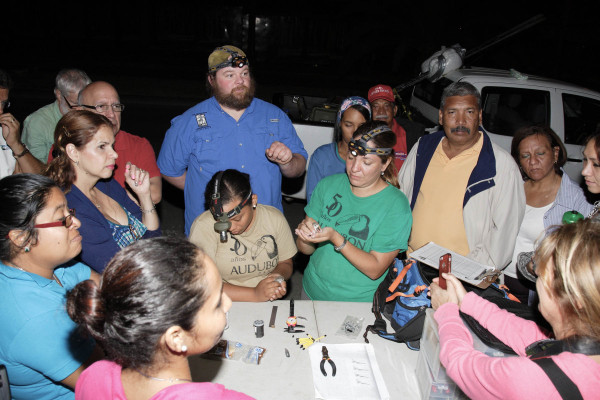Nurturing a flame in Panama

Grace Returns to Albemarle Sound March 25, 2015
March 27, 2015Grace Back at Tidewater Research Station March 29
March 30, 2015
When all of the high rhetoric of the day is packed away, conservation is about simple acts. It is about people deciding to make a better place for other species. It is about committing to the long path with your eyes fully open to the fact that much of the world is on a different path. It is about sustaining the level of passion required to prevail against whatever comes. In almost all situations, local people and organizations perform the simple acts that collectively hold the line.

An amazing shorebird dome forms over the mudflats in the Bay of Panama. Comprised of western sandpipers, the small plume of birds above is mostly short-billed dowitchers, illustrating the birds’ common tendency to size-segregate. Photo by Bart Paxton.
In the fall of 1997 when The Center for Conservation Biology conducted a baseline study to investigate waterbirds in the Bay of Panama, the Panama Audubon Society was primarily a close community of bird watchers focused on documenting the avifauna of this incredible country. In the years following our findings that the upper Bay of Panama supported one of the most significant concentrations of waterbirds in the world, Panama Audubon transformed itself and assumed the responsibility for protecting the local ecosystem on which the waterbirds depend.
Flocks of western sandpipers moving on and off shore along Pacora Beach in the upper Bay of Panama. Video by Panama Audubon Society.
Over nearly twenty years as government administrations, agencies, corporations, and varied socio-economic trends have threatened the habitats that undergird the system, Panama Audubon has stayed the course and championed the cause of waterbird conservation. Led by dynamo Rosabel Miró, the small group has faced down a never-ending parade of challenges to become an international force for waterbirds. In a time when so much attention is given to tinsel and lights, the group represents the essence of what conservation should be.

Jailene Alfaro (middle left) holds a western sandpiper as Yenifer Diaz (middle right) applies a coded leg flag. Fletcher Smith (left) looks on (left) while Rosabel Miró (right) records banding data. Photo by Bart Paxton.
The Center for Conservation Biology continues to support the Panama Audubon Society and efforts to protect the upper Bay of Panama for waterbirds. Our current focus is in helping to build the local experience and capacity needed to work directly with shorebirds. To this end, The Center has sent a team of shorebird biologists to work side by side with Panama Audubon staff for short periods during the past two winters (Shorebird dawn in Pacora).

Agency biologists, local media and members of Panama Audubon come out for an evening of shorebird banding. Panama Audubon staff Stefani Carti (left) and Yenifer Diaz (right) demonstrate banding techniques as Fletcher Smith from CCB looks on. Photo by Bart Paxton.
In early March of 2015, Bart Paxton and Fletcher Smith spent time training staff and volunteers of Panama Audubon on field techniques. On menu was training in bird capture, bird handling, bird banding, and surveys for flag resighting. With each experience, staff members have become more proficient in field techniques. Our belief is that local training will lead to the establishment of an experienced field team capable of executing field projects and training new generations of waterbird biologists that will continue the growing legacy of waterbird conservation.
A flock of shorebirds at Juan Diaz, Panama. Video by Rosabel Miró.
The Canadian Wildlife Service was a partner in the 2015 effort and we thank them for their continued support of shorebird conservation.
Written by Bryan Watts | bdwatt@wm.edu | (757) 221-2247
March 27, 2015
GALLERY:
[easy_image_gallery]
LOCAL NEWS:
Audubon marcará aves de la Bahía de Panamá | La Estrella de Panamá
Audubon anilla 175 aves playeras migratorias | La Estrella de Panamá
En la mira de científicos | Día a Día



